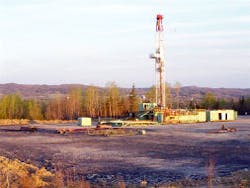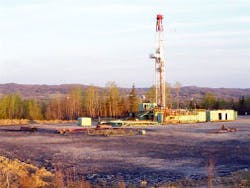Stealth Ventures Ltd. is pursuing coalbed methane plays in the Cumberland and Stellarton coal seams of Nova Scotia. The company has drilled two wells so far this year and holds acreage containing 1.6 tcf gross (1.313 tcf net) booked reserves.1 Chief operating officer, Derek Krivak told OGJ that Stealth has a $13 million (Can.) budget for 2006 and may be increasing this for 2007.
“If we drilled out all the pads and ran liners, we’d be looking at a capital expense of $60-80 million [Can.],” he said.
Coal
Basins of the Maritime Provinces in eastern Canada are underlain by Carboniferous and Permian sedimentary strata with conventional natural gas as well as coalbed methane development potential. Only Nova Scotia and neighboring New Brunswick have commercial coal operations.
Coal mining began in Cape Breton, NS in the 1720s and the province produced more than 400 million tons during 1863-2000. In 2000, Nova Scotia produced 1.1 million tons of coal, representing about 1.5% of Canadian coal production.2
The province relies on coal to generate about 80% of its electricity through Nova Scotia Power Inc. NSPI runs four generating stations that run on coal.
All of Nova Scotia’s coal is surface mined from seven small, privately owned mines; the last underground mine, the Prince Mine, closed in November 2001.
The province encourages clean-coal technology, defined by the World Coal Institute as “technology designed to enhance both the efficiency and environmental acceptability of coal extraction, preparation, and use.” Coalbed methane development falls under this banner, and seven CBM wells were drilled in Nova Scotia from 1994-96.3
In a May 17, 2005, presentation, the Canadian Society for Unconventional Gas reported a US National Petroleum Council study estimate that by 2025, “unconventional gas will account for about 80% of new drilling and 50% of gas production.”
The Nova Scotia Department of Energy, based in Halifax, administers onshore petroleum rights. The province issues coalbed methane rights for an initial 5-year term, renewable for another 5 years after a company completes a requisite work program. A production agreement is available after an acceptable development program has been filed. Nova Scotia’s coal gas royalty is 5% of monthly production, and there is no royalty holiday, as there is for conventional petroleum development.4
The government is reviewing the 20-year-old Energy Act and related legislation and may announce the revisions in fourth-quarter 2006, reflecting a “more progressive, flexible, goal-based approach” to hydrocarbon exploration.4
The Deptartment of Energy issued two calls for bids on CBM acreage this year. The first, Call 06-2, a 20,267-hectare (50,000-acre) block off northeastern Cape Breton, closed on June 19, 2006. The closing date for the second, Call 06-3, was July 4, 2006, and two blocks were offered onshore Cape Breton:
- Block 1, Inverness County, 9,650 hectares, includes three unconnected tracts on the west coast, near Mabou.
- Block 2, Cape Breton County, 20,175 hectares, includes three unconnected tracts on the north coast, near Sydney.
Players
From 1999-2003, only eight wells were drilled onshore Nova Scotia and most of the acreage was controlled by Devon Canada Corp. (OGJ, Aug. 9, 2004, p. 44). Calgary-based Contact Exploration Inc. acquired Devon’s petroleum rights, but only five additional wells were drilled onshore 2004 to June 2006.4
Contact is now Nova Scotia’s largest onshore leaseholder, with six parcels. The company has interests in about 2.3 million acres onshore Nova Scotia, as well as an exploration license in western Newfoundland and onshore New Brunswick.
The company began looking at coalbed methane in 2003-04, when it began investing in Amvest Nova Scotia Inc., Krivak said. Amvest previously held the rights to develop CBM in the Stellarton area.
On June 14, 2005, Stealth Ventures took over operatorship and now has 16 employees.
Stealth holds the first CBM agreement in Nova Scotia, for the Stellarton basin. On July 19, Nova Scotia Energy Minister Bill Dooks said he was “very encouraged by Stealth Ventures’ commitment to explore our onshore energy potential.”3
Cumberland
The Cumberland County coalfields include the Springhill and the Joggins-River Hebert coalfields. The Springhill mine is a reclamation rail-bed operation with an annual production capacity of 14,000 tons. Sulfur content of Springhill coals is about 1-3%.2
Cumberland coals are thinner than Stellarton’s, only as much as 100 ft stacked, but they are very gassy, Krivak said. Gas content of the Cumberland coals is as much as 500 scf/ton.5
Chief Financial Officer Mark Roth told OGJ that the company drilled its first Cumberland CBM well near Springhill in February, using a double rig provided by Doubil Inc., Beachville, Ont.
The Coal Mine Brook No. 3 well intersected more than 20 m of net coal in multiple seams, and intermediate casing was set in the No. 6 well at a vertical depth of about 1,133 m.
The company then drilled a 430-m horizontal lateral and ran a 425-m slotted liner in the Springhill Mines formation. Openhole testing began June 10, using downhole pumping equipment.
“We would have preferred to have the well testing sooner after completion of drilling, but equipment delays in this part of the world are a fact of life,” Roth said.
On June 16, the company announced this was the “first completion test on Stealth’s CBM properties, marking the start of a process required to bring resources to reserves.” Krivak said Stealth will spud the second Cumberland well in early August (Coal Mine Brook No. 12).
The company has set a 16-well pad and a 6-well pad and plans several more Cumberland CBM wells. Roth said that Stealth wants to “exploit multiple bedded seams at several azimuths,” decrease surface lease area, and drain large areas from single locations. The company is using PDC bits and has not planned any hydraulic fracturing.
Stealth Ventures Stealth has a 75% working interest in the well and in the Cumberland Exploration permit, which runs through 2009 and covers 177,000 acres. Contact Exploration retains a 25% working interest.
Stellarton
Stealth Ventures has 100% working interest in a 24,000-acre CBM production lease in the Stellarton sub-basin through 2011. Krivak told OGJ that the Stellarton play has 20 named, stacked coal seams, each 3-46 ft thick, and a total net coal thickness of nearly 400 ft.
The company spudded a CBM well in late May near Stellarton, using Precision Drilling Trust’s Rig 176, a telescoping double mobilized from Alberta. Roth said that Stealth is sharing this rig with other parties in the region “to defray the significant mobilization costs.”
The Priestville No. 4 well is Stealth’s second horizontal well this year. The company expects to drill additional wells and set a 20-well pad at Stellarton. In July, Krivak told OGJ that Stealth was taking cores near the wellsite.
Calgary’s Sproule Associates Ltd. estimated the discovered resource to be 425.7 bcf.1
The Stellarton, Coalburn, Thorburn, and Westville mines make up the Pictou coalfield. The Stellarton coal mine, run by the Pioneer Coal Co., is a reclamation open-pit operation with production capacity of 210,000 tons/year. Sulfur content of Pictou coals is about 0.8-3%.2
Gas content of the Stellarton coals that were tested ranged from 100-330 scf/ton.5
Stealth activity
Stealth has three drilling crews in Nova Scotia, with two crews working 12-hr shifts for 20 days, and one swing crew. Only two people among the three crews are from outside Atlantic Canada.
“We try to give as much work as we can, without adversely affecting our technical work program, to Atlantic Canadians, especially people from Nova Scotia,” Krivak said.
Stealth has laid out a 46-well program from the three pads and plans to drill in “pilot clusters” of three-four wells to move “resource to reserves.”
In addition to its CBM exploration, Stealth holds a large, undrilled permit to explore for conventional gas in Nova Scotia, and has conventional natural gas assets in Saskatchewan and Alberta.
References
- Gas resource play estimates by Calgary-based Sproule Associates Ltd., www.sproule.com.
- “Seizing the Opportunity: Nova Scotia’s Energy Strategy,” Vol. 2, Part IV, Coal, 17 pp.
- “Minister Encouraged by Onshore Potential,” Nova Scotia Dept. of Energy news release, July 19, 2006.
- “Nova Scotia Prospect Profile: Onshore 2006,” Nova Scotia Dept. of Energy, 9 pp.
- Stealth Ventures corporate presentation, May 15, 2006, www.stealthventures.ca/publications/May2006Stealth.pdf.
Valuing an unconventional resource
Once considered a dangerous nuisance and byproduct, coalbed methane is now a valuable resource. As natural gas prices soar, exploration turns to unconventional plays.
Geologist David Marchioni, president of Calgary-based Petro-Logic Services consultancy, recited several factors that influence the value of a CBM resource:
- Coal seam thickness and regional extent. The coal seams must be sufficiently thick to permit horizontal drilling.
- Gas content, expressed as cu. ft gas/ton of coal. The size of the resource is based on thickness, extent, and gas content.
- Maturity level of the coal. The rank of the coal, from peat to bituminous to anthracite, influences its gas content.
- Water content. Must pump off the water in order to reduce formation pressure and allow the gas to flow. Both water quality and water volume matter. There may be restrictions on pumping potable fresh water, because it would reduce local water supplies. There are also likely to be restrictions on the disposal of saline water.
- Permeability. Need permeability in order to flow gas, but if it’s too high, water could flow continually and the pressure never drop enough to allow gas flow.
- Financing. Need sufficient funds to cover land cost (or farm-in access), exploration, and drilling.
- Infrastructure. Need access to drilling equipment and a local market, a pipeline, or LNG facilities.
From: “Seven things you should know before investing in coalbed methane,” www.stockinterview.com.




